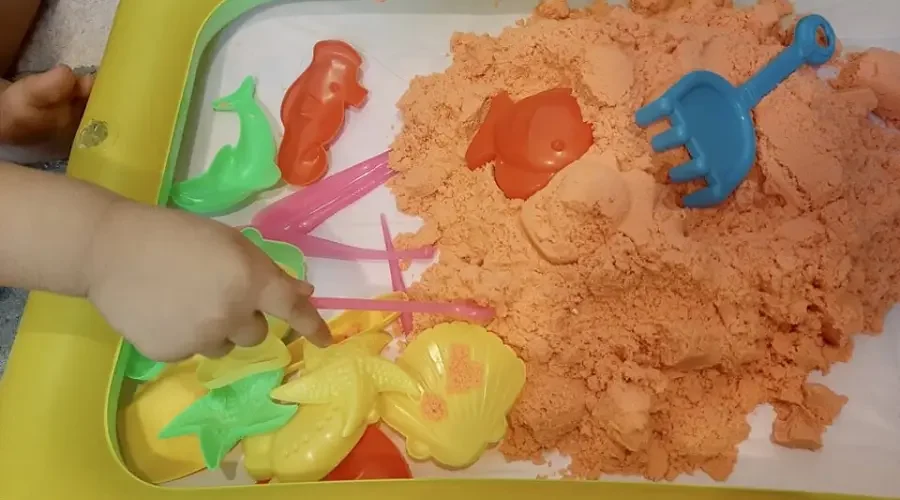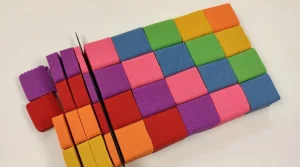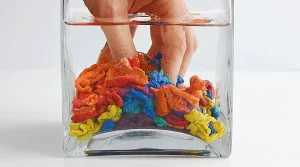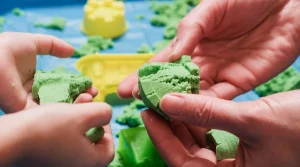
What Is Sensory Sand Made Of? The Science and Benefits
Explore what sensory sand is made of, why children love it, and how its unique materials enhance learning, creativity, and fine motor skills.
#1 Toys Manufacturer in China. WhatsApp: +86 180-0088-4063. Email: [email protected]
#1 Toys Manufacturer in China. WhatsApp: +86 180-0088-4063. Email: [email protected]

Kinetic sand is fun for everyone! From art projects to sensory bins, explore exciting ways to play. Want to unlock your creativity?
Kinetic Sand is a magical sensory play material. Made from regular sand coated with silicone oil, it feels like wet sand but doesn’t dry out. The silicone oil makes the sand stick together, allowing for easy sculpting and molding. Kids love it because they can build and shape without the mess of traditional sand.
Kinetic Sand’s unique properties make it ideal for sensory play. It flows through your fingers like a slow-moving liquid, providing a calming and satisfying experience. Plus, it’s non-toxic and safe for children, making it a perfect choice for parents looking for fun, safe play options.
Sensory play is crucial for children’s development. Activities like playing with Kinetic Sand help children develop fine motor skills and hand-eye coordination. They learn to manipulate the sand, build structures, and explore textures, which can enhance their creativity and problem-solving abilities.
For adults, Kinetic Sand offers stress relief. The tactile experience can be very relaxing, helping to reduce anxiety and promote mindfulness. Many adults find that playing with Kinetic Sand helps them unwind after a long day, providing a simple yet effective way to de-stress.
Starting with kinetic sand is easy and fun. First, you need to choose the right type of kinetic sand and gather some basic tools and accessories.
Each brand has its unique texture and color options. When choosing kinetic sand, consider the texture you prefer. Some sands are softer and more fluid, while others are firmer and hold shapes better.
There are a few key factors to consider when purchasing kinetic sand. Look for non-toxic and hypoallergenic options to ensure safety, especially for young children.
Having the right tools can enhance your kinetic sand play. Essential tools include molds, rollers, and shaping tools. These help create more detailed and intricate designs. Molds can be basic shapes or themed sets like castles and animals. Rollers and shaping tools add texture and detail to your creations.
You can also make DIY tools from household items. Cookie cutters, plastic forks, and small containers can all be repurposed for kinetic sand play.
For example, use a plastic fork to create lines and patterns in the sand. Small containers can be used as molds to shape the sand into different forms.
Classic play ideas with kinetic sand are simple and fun. Here’s how you can enjoy sculpting, molding, building sandcastles, and creating sensory bins.
Begin with simple shapes and figures. Use your hands or basic tools to form balls, cubes, and pyramids. These basic forms are the building blocks for more complex creations.
Once you’re comfortable, try advanced sculpting techniques. You can carve out intricate designs and details. For example, use a plastic knife to create a detailed dinosaur or a tiny castle. A small brush can add texture to surfaces, making your sculptures look more realistic.
Creating themed sensory bins with kinetic sand is a versatile way to play. Sensory bins are containers filled with kinetic sand and other elements to stimulate the senses.
Start by choosing a theme. For example, an ocean-themed bin can include blue kinetic sand, small plastic sea creatures, and seashells. A construction-themed bin might have brown sand, toy trucks, and small rocks.
Incorporate other sensory elements to make the experience richer. Add scented oils for smell, or different textures like dried beans or rice. Small toys and natural elements, like pine cones or leaves, can also add variety.
Innovative play with kinetic sand brings creativity and learning together.
Try a kinetic sand treasure hunt. Hide small toys or objects in the sand and have players dig to find them. This game is great for developing fine motor skills and can be a fun group activity.
Sculpting competitions are another exciting way to play. Set a timer and see who can create the most detailed sculpture in a limited time. You can choose themes like animals, buildings, or fantasy creatures. This adds a competitive edge and encourages creativity.
Kinetic sand can be used for creative art projects. One idea is to make kinetic sand art on canvases. Spread a thin layer of sand on a canvas and use tools to create patterns or pictures. Once the design is complete, you can preserve it with a clear sealant.
Another fun project is creating layered kinetic sand bottles. Use different colors of kinetic sand and layer them in clear bottles to make beautiful, decorative pieces. These bottles can be used as room decorations or unique gifts.
Use it to help children learn shapes, letters, and numbers. Form the sand into different shapes and have kids identify them. You can also create letters and numbers for kids to trace with their fingers.
Science experiments with kinetic sand can be very educational. For example, you can explore concepts like friction and cohesion. Show how the sand sticks together due to its coating, and compare it to regular sand. These experiments make learning interactive and fun.
Playing with kinetic sand helps with stress relief, improves fine motor skills, and encourages creativity and imagination.
Kinetic sand can be a great tool for relaxation. Its smooth, flowing texture can be very calming. Many adults find that simply running their fingers through the sand or shaping it into forms helps reduce stress.
Incorporating kinetic sand into mindfulness practices is easy. During meditation or quiet time, use kinetic sand to focus your mind. Slowly mold the sand, paying attention to its texture and movement. This tactile experience can enhance your mindfulness practice, helping you stay grounded and present.
Activities that involve molding, shaping, and cutting the sand help enhance hand-eye coordination. For example, you can roll the sand into thin snakes or create small balls. These simple tasks strengthen the muscles in your fingers and hands.
Kinetic sand play sparks creativity and imagination. Because the sand is so easy to shape, it’s perfect for open-ended play.
Children and adults can create anything they imagine, from castles to creatures. This type of play encourages creative thinking and problem-solving.
Role-playing and storytelling with kinetic sand can make playtime even more engaging. Set up scenes with the sand and small toys, and create stories around them.
Proper maintenance and storage keep kinetic sand in good condition.
When playing, try to keep the sand in a designated area to avoid contamination. If the sand gets dirty, pick out any visible debris with your hands.
If kinetic sand spills onto the floor, use a dustpan and brush to gather it. For smaller pieces, you can use a piece of tape to pick them up. If the sand gets wet, spread it out on a flat surface and let it air dry. It will return to its original texture once dry.
The best containers for storage are airtight plastic bins. These prevent the sand from drying out and protect it from dust and dirt. Choose a bin that’s big enough to hold all your sand and has a secure lid.
Use smaller containers or zip-lock bags to keep molds, rollers, and other tools together. Labeling these containers can help you find what you need quickly. A divided storage box can keep everything in one place and make cleanup easier.
Playing with kinetic sand is not only fun but also beneficial for all ages. From stress relief and fine motor skill development to sparking creativity and imaginative play, kinetic sand offers endless possibilities.
Kinetic sand is designed to stay moist, but if it feels dry, you can revive it by adding a few drops of water and kneading it until it returns to its original texture.
Yes, kinetic sand is non-toxic and safe for children. However, it’s best to supervise young kids during play to prevent them from putting the sand in their mouths.
Yes, you can mix different colors of kinetic sand to create new shades and patterns. Keep in mind that once mixed, the colors cannot be separated.
Flat, smooth surfaces like tables, trays, or play mats are ideal for playing with kinetic sand. These surfaces help contain the sand and make cleanup easier.
If kinetic sand sticks to your hands, simply rinse them with water and dry them thoroughly. The sand should then flow easily without clinging to your skin.
More Related...

Explore what sensory sand is made of, why children love it, and how its unique materials enhance learning, creativity, and fine motor skills.

Discover what makes kinetic sand so special — from its unique texture to the fascinating science behind its magical movement.

Is magic sand safe for kids? Explore safety facts, age guidelines, and expert advice to ensure fun, creative, and secure sensory play.

Kinetic sand toys offer fun and education in one—find out how they support child development, relaxation, and imaginative play.

Our team will answer your inquiries within 48 hours.
Copyright © 2025 GuangDong AKIA Technology Co,. Ltd. All Rights Reserved